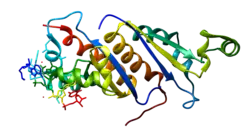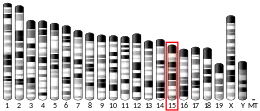KHDRBS3
La KHDRBS3 (pour « KH domain-containing, RNA-binding, signal transduction-associated protein 3 » en anglais) est une protéine codée par le gène KHDRBS3, présent sur le chromosome 8 humain et le chromosome 15 de la souris[4],[5],[6].
| KHDRBS3 | |||||||||||||||||||||||||||||||||||||||||||||||||||
|---|---|---|---|---|---|---|---|---|---|---|---|---|---|---|---|---|---|---|---|---|---|---|---|---|---|---|---|---|---|---|---|---|---|---|---|---|---|---|---|---|---|---|---|---|---|---|---|---|---|---|---|
 | |||||||||||||||||||||||||||||||||||||||||||||||||||
| Visualisation de la protéine Cristallisée KHDRBS3 | |||||||||||||||||||||||||||||||||||||||||||||||||||
| |||||||||||||||||||||||||||||||||||||||||||||||||||
| Identifiants | |||||||||||||||||||||||||||||||||||||||||||||||||||
| Aliases | KHDRBS3 | ||||||||||||||||||||||||||||||||||||||||||||||||||
| IDs externes | OMIM: 610421 MGI: 1313312 HomoloGene: 4780 GeneCards: KHDRBS3 | ||||||||||||||||||||||||||||||||||||||||||||||||||
| |||||||||||||||||||||||||||||||||||||||||||||||||||
| |||||||||||||||||||||||||||||||||||||||||||||||||||
| |||||||||||||||||||||||||||||||||||||||||||||||||||
| |||||||||||||||||||||||||||||||||||||||||||||||||||
| Wikidata | |||||||||||||||||||||||||||||||||||||||||||||||||||
| |||||||||||||||||||||||||||||||||||||||||||||||||||
Notes et références
- (en) Cet article est partiellement ou en totalité issu de l’article de Wikipédia en anglais intitulé « KHDRBS3 » (voir la liste des auteurs).
- GRCm38: Ensembl release 89: ENSMUSG00000022332 - Ensembl, May 2017
- « Publications PubMed pour l'Homme », sur National Center for Biotechnology Information, U.S. National Library of Medicine
- « Publications PubMed pour la Souris », sur National Center for Biotechnology Information, U.S. National Library of Medicine
- (en) Venables JP, Vernet C, Chew SL, Elliott DJ, Cowmeadow RB, Wu J, Cooke HJ, Artzt K, Eperon IC, « T-STAR/ETOILE: a novel relative of SAM68 that interacts with an RNA-binding protein implicated in spermatogenesis », Hum Mol Genet, vol. 8, no 6, , p. 959–69 (PMID 10332027, DOI 10.1093/hmg/8.6.959).
- (en) Lee J, Burr JG, « Salpalpha and Salpbeta, growth-arresting homologs of Sam68 », Gene, vol. 240, no 1, , p. 133–47 (PMID 10564820, DOI 10.1016/S0378-1119(99)00421-7).
- (en) « Entrez Gene: KHDRBS3 KH domain containing, RNA binding, signal transduction associated 3 ».
- (en) Rual JF, Venkatesan K, Hao T, Hirozane-Kishikawa T, Dricot A, Li N, Berriz GF, Gibbons FD, Dreze M, Ayivi-Guedehoussou N, Klitgord N, Simon C, Boxem M, Milstein S, Rosenberg J, Goldberg DS, Zhang LV, Wong SL, Franklin G, Li S, Albala JS, Lim J, Fraughton C, Llamosas E, Cevik S, Bex C, Lamesch P, Sikorski RS, Vandenhaute J, Zoghbi HY, Smolyar A, Bosak S, Sequerra R, Doucette-Stamm L, Cusick ME, Hill DE, Roth FP, Vidal M, « Towards a proteome-scale map of the human protein-protein interaction network », Nature, vol. 437, no 7062, , p. 1173–8 (PMID 16189514, DOI 10.1038/nature04209).
- (en) Venables JP, Dalgliesh C, Paronetto MP, Skitt L, Thornton JK, Saunders PT, Sette C, Jones KT, Elliott DJ, « SIAH1 targets the alternative splicing factor T-STAR for degradation by the proteasome », Hum. Mol. Genet., vol. 13, no 14, , p. 1525–34 (PMID 15163637, DOI 10.1093/hmg/ddh165).
Bibliographie
|
|
Voir aussi
Cet article est issu de Wikipedia. Le texte est sous licence Creative Commons – Attribution – Partage à l’identique. Des conditions supplémentaires peuvent s’appliquer aux fichiers multimédias.


